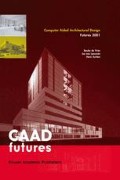Abstract
Architectural walkthroughs have often been presented as prime examples of applications that can benefit from Virtual Reality (VR) technology, but still VR presentations can be disappointing. A main reason for this is that most VR applications have been developed on purely technical criteria, with an emphasis on geometrical precision rather than experiential quality. In this paper we present a human-centered analysis and propose design solutions, by focusing on the narrative aspects of the walkthrough, such as connecting transitions of the kind used in contemporary computer games. The solutions show how such narrative enhancements can improve the user’s experience of presentations at modest technical expense.
Access this chapter
Tax calculation will be finalised at checkout
Purchases are for personal use only
Preview
Unable to display preview. Download preview PDF.
References
Alexander, C. 1977, A pattern language, Oxford University Press, New York.
Carson, D., 2000, Environmental storytelling, Gamasutra web archive, http://www.gamasutra.com/features/2000030l/carson_01.htm
Costikyan, G. (2000) Where stories end and games begin. Game Developer, Sept., 44–53.
Cruz-Neira, C., Sandin, D.J., & DeFanti, T.A. (1993) Surround-screen projection-based Virtual Reality: the design and implementation of the CAVE. Computer Graphics: Proceedings of SIGGRAPH’ 93, August 1993.
Gebriel, R.P. 1996, Patterns of Software, Oxford University Press, New York.
Hecker, C., & Simpson, Z.B. (2000) Game programming patterns & idioms. Game Developer, Sept., 12–13.
Laurel, B., 1993, Computers as theatre, Addison Wesley Longman Inc., City.
Mountford, S.J., & Gaver, W.W. (1990) Talking and listening to computers. In: Laurel, B. (Ed), The Art of Human-Computer Interface Design. Addison-Wesley, 319–334.
Pausch, R., Snoddy, J, Taylor R., Watson S. and Haseltine, E., 1996, “Disney’s Aladdin: First Steps Toward Storytelling in Virtual Reality”, Computer Graphics Proceedings, Annual Conference Series, 23(4), p. 193–203.
Stappers, P.J., Gaver, W.W., & Overbeeke, C.J., (2001) Beyond the limits of real-time realism. In: Hettinger, L.J., & Haas, M.W., Psychological Issues in the Design and Use of Adaptive, Virtual Interfaces. Erlbaum, New York
Author information
Authors and Affiliations
Editor information
Editors and Affiliations
Rights and permissions
Copyright information
© 2001 Springer Science+Business Media Dordrecht
About this paper
Cite this paper
Stappers, P.J., Saakes, D., Adriaanse, J. (2001). On the narrative structure of Virtual Reality walkthroughs. In: de Vries, B., van Leeuwen, J., Achten, H. (eds) Computer Aided Architectural Design Futures 2001. Springer, Dordrecht. https://doi.org/10.1007/978-94-010-0868-6_10
Download citation
DOI: https://doi.org/10.1007/978-94-010-0868-6_10
Publisher Name: Springer, Dordrecht
Print ISBN: 978-94-010-3843-0
Online ISBN: 978-94-010-0868-6
eBook Packages: Springer Book Archive

